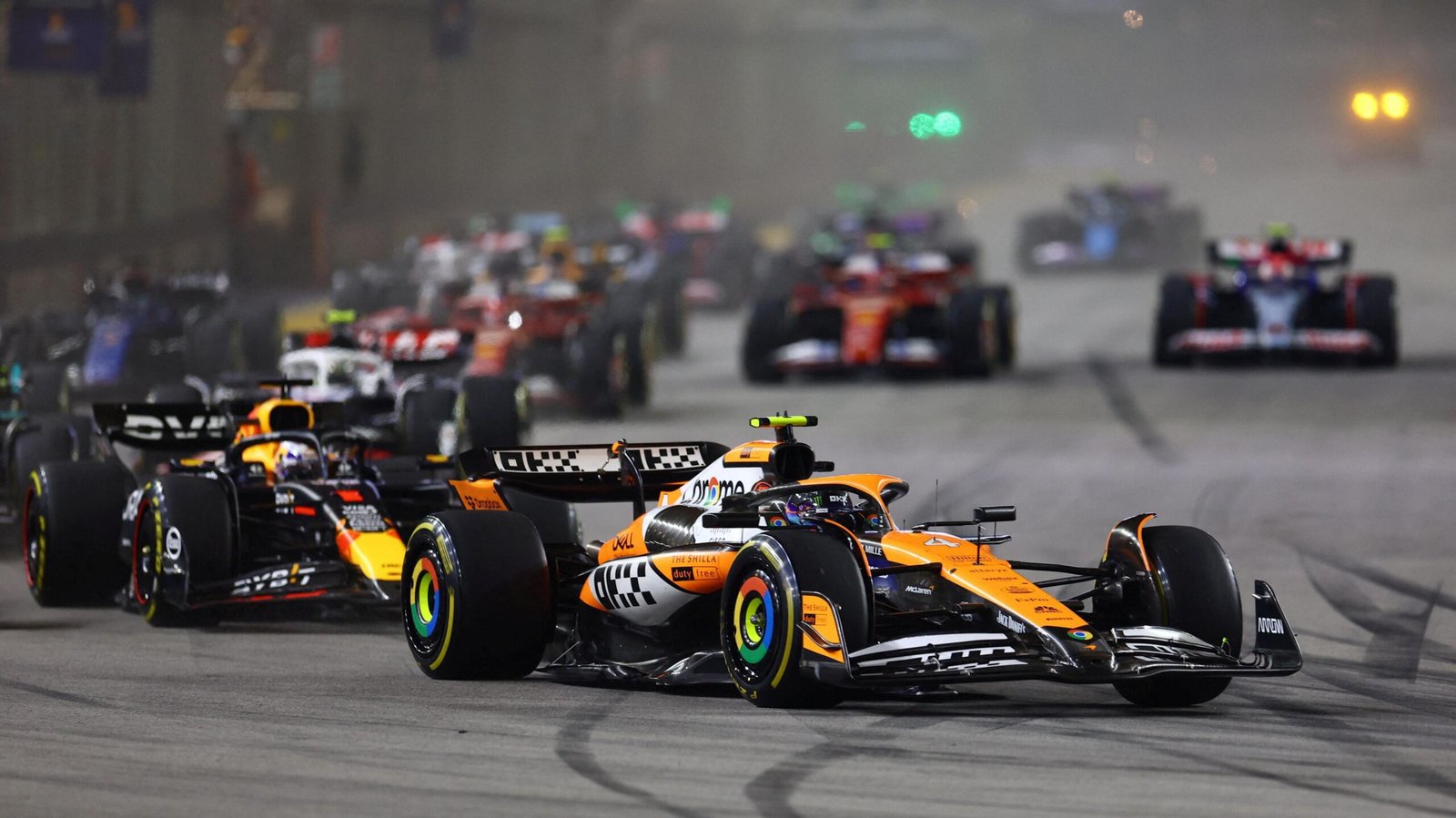Formula 1 is no stranger to extreme conditions from torrential rains at Spa to sandstorms in Bahrain. But in October 2025, at the Singapore Grand Prix, the FIA made history by declaring the sport’s first-ever “Heat Hazard” race. This unprecedented classification reflects not only the growing challenge of racing in hot, humid climates but also the sport’s urgent response to driver safety, climate change, and race logistics.
In this article, we’ll explore what the “Heat Hazard” means, why it was introduced, its impact on drivers and teams, and what this decision signals for the future of F1.
What is a “Heat Hazard” in F1?
The FIA introduced the “Heat Hazard” status to formally recognize when temperature and humidity levels pose a serious risk to driver health and race safety.
- Temperature spikes: Track temps in Singapore exceeded 55°C (131°F).
- Humidity overload: Combined with 80–85% humidity, cockpit conditions became unbearable.
- Driver exposure: A driver inside an F1 car can experience body temps of 39–40°C and lose up to 3–4 liters of sweat during a race.
Previously, extreme heat was acknowledged informally, but the FIA had no structured classification or protocol. Declaring a “Heat Hazard” sets a benchmark for when additional safety protocols, cooling strategies, and medical preparedness must be deployed.
Why Singapore GP Triggered the First “Heat Hazard”
Singapore’s Marina Bay Circuit has always tested endurance. It’s:
- One of the longest races on the calendar (often hitting the two-hour limit).
- A night race, but humidity levels remain oppressive even after sunset.
- Urban heat effect: The city layout traps heat and raises temperatures further.
During practice sessions, multiple drivers complained of dizziness, dehydration, and heat stress. The FIA’s monitoring systems flagged that conditions had crossed the newly defined threshold, forcing them to act.
FIA’s Safety Measures Under the Heat Hazard Protocol
Once the Heat Hazard was declared, the FIA implemented several unprecedented safeguards:
- Cooling Vests: Drivers were provided with pre-race cooling garments to stabilize core temperature.
- Pitlane Ice Protocols: Teams were permitted to use additional ice packs and cooling fans during pit stops.
- Medical Staffing Boost: Extra paramedics and hydration facilities were stationed around the track.
- Driver Briefings: FIA officials warned teams of the risk, mandating stricter post-race medical checks.
While these steps helped, some drivers still reported extreme difficulty, sparking debate over whether Singapore’s conditions are sustainable for F1’s future.
The Human Cost: How Drivers Cope with Heat
F1 drivers are among the most elite athletes in the world, but heat stress in Singapore pushed them to their limits:
- Cognitive Impact: Heat exhaustion reduces focus and reaction times, dangerous at 300 km/h speeds.
- Physical Stress: Dehydration causes muscle cramps, blurred vision, and slower reflexes.
- Mental Fatigue: Drivers must balance race strategy, overtaking, and communication, all while fighting heat exhaustion.
Some comparisons:
- A driver can lose more than 3kg of body weight from sweating alone during Singapore.
- Drivers’ heart rates often exceed 190 bpm for nearly two hours.
- Max Verstappen and Lewis Hamilton both admitted in past years that Singapore “feels like racing in a sauna.”
Comparisons: How F1 Has Handled Other Extreme Conditions
The Heat Hazard is just one more chapter in F1’s adaptation to environmental extremes:
- Rain Hazards: Races like Spa 2021 were abandoned due to heavy rainfall and low visibility.
- Dust Storms: Bahrain has seen sand interfere with practice sessions.
- Cold Snaps: Nürburgring 2020 witnessed unusually cold conditions, altering tire performance.
But while other hazards affect cars, heat uniquely attacks the driver’s body, making it one of the most dangerous risks in motorsport.
Climate Change and Formula 1’s Future
The first Heat Hazard raises uncomfortable questions about F1’s sustainability in an era of rising global temperatures:
- Asian & Middle Eastern races are increasingly at risk of dangerous heat levels.
- Calendar density makes rescheduling difficult, but F1 may need to reconsider timing for tropical GPs.
- Net Zero by 2030: F1’s climate commitments now extend beyond carbon footprints to driver health in changing climates.
The FIA is under pressure to adopt adaptive measures, including:
- Shifting race timings to cooler months.
- Shortening race lengths in extreme conditions.
- Expanding Heat Hazard rules into a structured multi-level scale (similar to rain safety categories).
Team Strategies Under Heat Hazard Conditions
Teams also face challenges adapting strategy:
- Tire Management
- Higher track temps affect tire wear and grip.
- Teams must calculate between aggressive tire choices vs. endurance setups.
- Higher track temps affect tire wear and grip.
- Car Cooling
- Openings in the car bodywork for better airflow can reduce aerodynamic efficiency.
- Balancing cooling vs. performance is a crucial tradeoff.
- Openings in the car bodywork for better airflow can reduce aerodynamic efficiency.
- Driver Hydration Systems
- Some drivers reported malfunctioning drink bottles, a nightmare under Heat Hazard conditions.
- Teams are expected to invest in more reliable hydration delivery systems.
- Some drivers reported malfunctioning drink bottles, a nightmare under Heat Hazard conditions.
Fan Reactions and Media Buzz
Fans and media have reacted strongly:
- Safety Concerns: Many argue that “no spectacle is worth risking driver health.”
- F1 Drama: Others see it as another layer of intensity, making races even more unpredictable.
- Social Media: Hashtags like #HeatHazardGP and #SingaporeSurvival trended, fueling debates about FIA’s responsibility.
Will Heat Hazards Change the F1 Calendar?
The Singapore GP might just be the start:
- Qatar and Abu Dhabi are also vulnerable to extreme heat.
- Las Vegas could face similar risks during summer races.
- New venues in regions with hotter climates must be carefully assessed.
Some insiders suggest F1 may have to:
- Avoid certain months for tropical races.
- Expand night race formats for heat management.
- Reconsider double-header weekends in hot zones.
Expert Opinions
- James Vowles (Williams): Suggested shorter race weekends, indirectly reducing driver fatigue.
- Medical Experts: Stress the need for stricter hydration and monitoring protocols.
- Ex-Drivers: Jenson Button and Nico Rosberg argued that the FIA must “future-proof” safety as climate risks worsen.
The first-ever Heat Hazard in F1 history marks a turning point for the sport. It highlights the intersection of human endurance, climate challenges, and racing spectacle. As Formula 1 expands globally, the Heat Hazard protocol may evolve into one of the most critical safety frameworks, shaping how and where the sport races in the coming decade.
What’s clear: Singapore 2025 wasn’t just another race. It was a warning. The FIA’s decision could redefine how F1 balances the thrill of racing with the realities of our changing world.
















